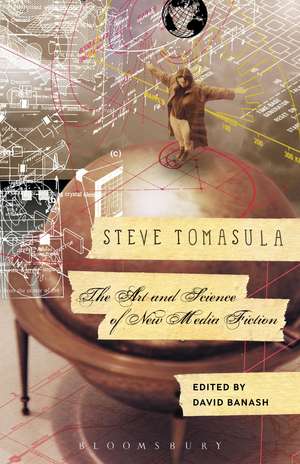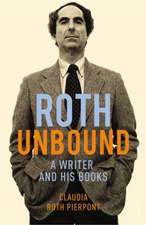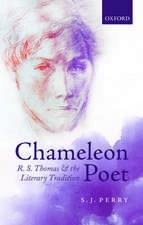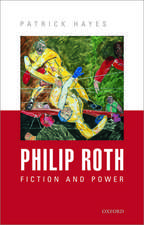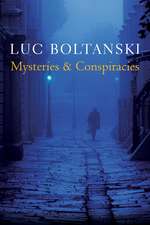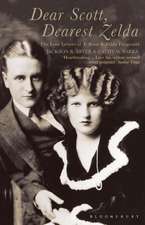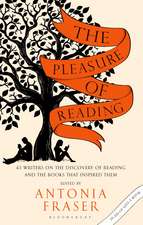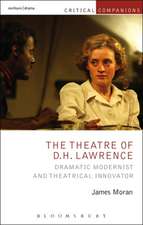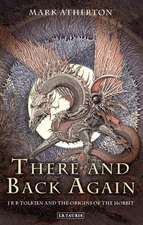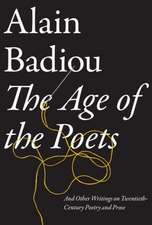Steve Tomasula: The Art and Science of New Media Fiction
Editat de Professor David Banashen Limba Engleză Hardback – 15 iul 2015
Preț: 832.65 lei
Preț vechi: 1066.88 lei
-22% Nou
Puncte Express: 1249
Preț estimativ în valută:
159.35€ • 173.03$ • 133.85£
159.35€ • 173.03$ • 133.85£
Carte tipărită la comandă
Livrare economică 22 aprilie-06 mai
Preluare comenzi: 021 569.72.76
Specificații
ISBN-13: 9781628923681
ISBN-10: 1628923687
Pagini: 344
Ilustrații: 42 halftones
Dimensiuni: 140 x 216 x 28 mm
Greutate: 0.54 kg
Editura: Bloomsbury Publishing
Colecția Bloomsbury Academic
Locul publicării:New York, United States
ISBN-10: 1628923687
Pagini: 344
Ilustrații: 42 halftones
Dimensiuni: 140 x 216 x 28 mm
Greutate: 0.54 kg
Editura: Bloomsbury Publishing
Colecția Bloomsbury Academic
Locul publicării:New York, United States
Caracteristici
The first book on an increasingly influential and innovative American author that shows how Steve Tomasula is redefining the form of the novel
Notă biografică
David Banash is Professor of English at Western Illinois University, USA. He is the author of Collage Culture: Readymades, Meaning, the Age of Consumption (2013) and co-editor of Contemporary Collecting: Objects, Practices, and the Fate of Things (2013). His essays and reviews have appeared in American Book Review, Bad Subjects: Political Education for Everyday Life, Science Fiction Studies, Paradoxa, PopMatters, Postmodern Culture, Reconstruction, and the Iowa Review.
Cuprins
1. "Variations on a Theme": the (re)Invention of the Human in Vas: An Opera in FlatlandSylvie Bauer (Université Rennes 2, France)2. The Great American Novel: System UpdateKathi Inman Berens (University of Southern California, Annenberg School of Communication, USA)3. Tomasula's BookR. M. Berry (Florida State University, USA)4. Fabrications in a Complex Mirror: Steve Tomasula's Turbulent FictionGerald Bruns (University of Notre Dame, USA)5. Literary Archaeologies in The Book of PortraitureFlore Chevaillier (Central State University, USA)6. The Material Is the Message: Body as Text/Text as Body in Steve Tomasula's VAS: An Opera in FlatlandAnthony Enns (Dalhousie University, Canada)7. A Book, an Atlas, and an Opera: Steve Tomasula's Fictions of Science as Science FictionPawel Frelik (Maria Curie-Sklodowska University, Lublin, Poland)8. Spatiality and Print, Temporality and Digital Media: Media-Specific Strategies in Steve Tomasula's The Book of Portraiture and TOCN. Katherine Hayles (Duke University, USA)9. The Work of Art After the Mechanical AgeMary Holland (SUNY, New Paltz, USA)10. Intermediality in Steve Tomasula's TOC: A New Media Novel: A Semiological AnalysisAnne Hurault-Paupe (Paris 13 University, France)11. Exploration and Discovery Through Visuality in Steve Tomasula's The Book of PortraiturePelin Iscan (University of Strasbourg, France)12. Do We Not Bleed? The Color of Flesh in a Cyborg WorldAnne Larue (University Paris 13-Sorbonne Paris Cité, France)13. Ontological Metalepses, Unnatural Narratology, & Locality: A Politics of the [[page]] in Tomasula's VAS & TOCLance Olsen (University of Utah, USA)14. 'Still, It Moves' : The Subreal Fiction of Steve TomasulaJackie Orr (Syracuse University, USA)15. Enumeration in Steve Tomasula's Short StoriesFrançoise Palleau-Papin (University of Paris 13-Sorbonne Paris Cité, France)16. Encoding the Body, Questioning Legacy: Reflections on Intersemiotic Experiments in Steve Tomasula's VAS: An Opera in FlatlandFrançoise Sammarcelli (University of Paris Sorbonne, France)17. Steve Tomasula's Work of WonderAnne-Laure Tissut (Rouen University, France)Afterword-An Interview with Steve TomasulaBibliography Index
Recenzii
David Banash and this excellent collection do more than bring Steve Tomasula's astounding work to a wider audience. This book reveals the multiform layers of interlacing aesthetics that, like a tumor, a clock, a biological accident, and the birth of the alphabet, assemble into patterns that are playful, enigmatic, and wondrous. Tomasula was once the best-kept secret in contemporary narrative. Now, his work is suitably viral.
A groundbreaking collection of essays on an author who is at the cutting edge of experimental fiction in the twenty-first century.
Steve Tomasula's eco-hybrid, post-cyber, transmedia fiction works are as hard to characterize as they are engaging. Only a genetically engineered polydactyl would have enough thumbs to signal the enthusiasm generated by the digerati-literati lucky enough to have encountered them in the first decade of the new millennium. Varied and eclectic, sui generis and virtuosic, Tomasula's major works get their due in this volume as a wide range of authors, eager and equal to the task, position his activities within the critical discourses proliferating at the intersection of creative thought and literary philosophy.
What is a work that arrives before it is written? What is a work that emerges from the soft tissue of the body at different points in a given era? How do make a new kind of writing derived from the oscillation between two rectangles of light; frames that might include surveillance, animal ethologies and anatomies, as much as a philosophy of the book-to-be? This extraordinary anthology constellates readings of Tomasula novels and intermedia projects that offer us a glimpse of the novel as installation, as 'nature opening out to culture.' As someone interested in what happens at the intersection of narrative and biology, the instance of mutation as a trait transmitted between and across texts of different kinds, I was very inspired by the essays in this remarkable collection. David Banash has curated something that makes it possible to come to writing again, differently. The introduction, co-written with Andrea Spain, was, itself, a fierce and brilliant consideration of 'composition, emergence, sensation': the intense, unpredictable and sometimes violent energies that underlie Tomasula's work in its incipient stages, but also carry it through a duration. Which is prose. Which is this other kind of radical art. An art or novel that appears only when we orient towards it. In this way.
A groundbreaking collection of essays on an author who is at the cutting edge of experimental fiction in the twenty-first century.
Steve Tomasula's eco-hybrid, post-cyber, transmedia fiction works are as hard to characterize as they are engaging. Only a genetically engineered polydactyl would have enough thumbs to signal the enthusiasm generated by the digerati-literati lucky enough to have encountered them in the first decade of the new millennium. Varied and eclectic, sui generis and virtuosic, Tomasula's major works get their due in this volume as a wide range of authors, eager and equal to the task, position his activities within the critical discourses proliferating at the intersection of creative thought and literary philosophy.
What is a work that arrives before it is written? What is a work that emerges from the soft tissue of the body at different points in a given era? How do make a new kind of writing derived from the oscillation between two rectangles of light; frames that might include surveillance, animal ethologies and anatomies, as much as a philosophy of the book-to-be? This extraordinary anthology constellates readings of Tomasula novels and intermedia projects that offer us a glimpse of the novel as installation, as 'nature opening out to culture.' As someone interested in what happens at the intersection of narrative and biology, the instance of mutation as a trait transmitted between and across texts of different kinds, I was very inspired by the essays in this remarkable collection. David Banash has curated something that makes it possible to come to writing again, differently. The introduction, co-written with Andrea Spain, was, itself, a fierce and brilliant consideration of 'composition, emergence, sensation': the intense, unpredictable and sometimes violent energies that underlie Tomasula's work in its incipient stages, but also carry it through a duration. Which is prose. Which is this other kind of radical art. An art or novel that appears only when we orient towards it. In this way.
